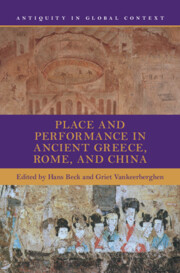
-
Select format
-
- Publisher:
- Cambridge University Press
- Publication date:
- November 2024
- December 2024
- ISBN:
- 9781009389983
- 9781009390026
- Dimensions:
- (229 x 152 mm)
- Weight & Pages:
- 0.85kg, 486 Pages
- Dimensions:
- Weight & Pages:
- Subjects:
- Ancient History, East Asian History, Classical Studies, Area Studies, Asian Studies, History, Global History
- Series:
- Antiquity in Global Context
You may already have access via personal or institutional login- Subjects:
- Ancient History, East Asian History, Classical Studies, Area Studies, Asian Studies, History, Global History
- Series:
- Antiquity in Global Context
Book description
This book examines the construction of space and place in early China and the ancient Mediterranean through the lens of performances conducted in specific locations. It highlights conceptions of place and performance, seeing both as crucial to the production of cultural meaning and communal cohesion, and as heavily dependent on the prevailing political culture. Whether urban or rural, global or local, central or fringe, public or private, real or imagined, theatrical or ritual, the places and performances highlighted serve to show both commonalities and differences between the ancient Mediterranean and early China. The range of places of comparison is also very diverse, including roads, gardens, neighbourhoods, hydraulic infrastructures, funerary performance, spectacles at court, and the everyday display of authority through clothing and fashion. This title is part of the Flip it Open Programme and may also be available Open Access. Check our website Cambridge Core for details.
Contents
Metrics
Full text views
Full text views help Loading metrics...
Loading metrics...
* Views captured on Cambridge Core between #date#. This data will be updated every 24 hours.
Usage data cannot currently be displayed.
Accessibility standard: Missing or limited accessibility features
Why this information is here
This section outlines the accessibility features of this content - including support for screen readers, full keyboard navigation and high-contrast display options. This may not be relevant for you.
Accessibility Information
The PDF of this book is known to have missing or limited accessibility features. We may be reviewing its accessibility for future improvement, but final compliance is not yet assured and may be subject to legal exceptions. If you have any questions, please contact accessibility@cambridge.org.
Content Navigation
Table of contents navigation
Allows you to navigate directly to chapters, sections, or non‐text items through a linked table of contents, reducing the need for extensive scrolling.
Index navigation
Provides an interactive index, letting you go straight to where a term or subject appears in the text without manual searching.
Reading Order and Textual Equivalents
Single logical reading order
You will encounter all content (including footnotes, captions, etc.) in a clear, sequential flow, making it easier to follow with assistive tools like screen readers.
Visual Accessibility
Use of colour is not sole means of conveying information
You will still understand key ideas or prompts without relying solely on colour, which is especially helpful if you have colour vision deficiencies.
Structural and Technical Features
ARIA roles provided
You gain clarity from ARIA (Accessible Rich Internet Applications) roles and attributes, as they help assistive technologies interpret how each part of the content functions.


